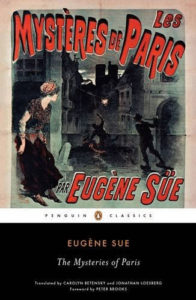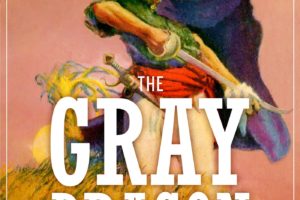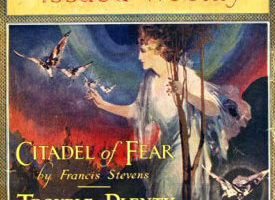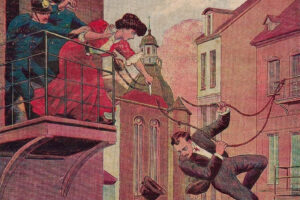
In the past I have posted on works that preceded the pulps, both U.S. and foreign, including works from storypapers and dime novels. But nothing is more “proto pulp” then Eugène Sue‘s The Mysteries of Paris, now out in a new translation from Penguin Books. Be advised this is a long work, coming in at about 1,400 pages!
Eugène Sue (1804-1857) is largely forgotten today, which is unfortunate. He established the genre of serialized novels with The Mysteries of Paris, which appeared over 150 parts in 1842-43. It was soon published in 10 volumes. His second most well-known work is The Wandering Jew, which was also serialized.
The Mysteries of Paris is important is that it launched a large number of imitators referred to as “city mysteries” in Europe and America in the 1800s. This genre focused on the “mysteries and miseries” in various cities, basically the secret underworlds revealing the corruption and exploitation of the lower classes, and the indifference of the upper classes. Some of the better known of these works is Paul Feval‘s The Mysteries of London, which is a forerunner to his later Black Coats series (Black Coat Press has published the Black Coat series, but only put out the stage play version of The Mysteries of London under the title The Gentlemen of the Night); Ponson du Terrail‘s The Dramas of Paris, which would introduce the character of Rocambole; and even later-day works like The Mysteries of Lyon, which featured the Nyctalope, and The New Mysteries of Paris, which featured detective Nestor Burma.
The Mysteries of Paris is also credited as an inspiration for both Les Miserabiles and The Count of Monte Cristo (the Count was specifically written to imitate the success of Sue’s work).
In The Mysteries of Paris, we see the prototype of many of these and later works. The hero of the work is Rodolphe, a mysterious and distinguished individual. Though he appears to be an average Parisian worker, he is really the Grand Duke of Gerolstein (a fictional German state). He is also extremely strong, has good judgement, a brilliant mind, and is an excellent fighter (the prototypical larger-than-life fictional hero).
While part of the upper class, he has great compassion for the lower classes, and can navigate all layers of society in order to understand their problems and be able to help those he finds. He even speaks the slang of the working classes. He is accompanied by his friends Sir Walter Murph, an Englishman, and David, a gifted black doctor and former slave (you’ll learn more of his story in the book).
Through the long novel, Rodolphe helps many people, who are all grateful, as well as dealing with several sinister characters. At the beginning, Rodolphe rescues the young Songbird from an attack by The Slasher. Then the three go to a local tavern to share stories of themselves. Songbird is a young girl of 17. Orphaned at a young age, she was “raised” by the horrible Owl, but escaped and put into a debtors prison until she turned 16. Now she tries to make her way in life as best she can. The Slasher was a former butcher turned soldier, who went crazy, slashed several soldiers, and was sentenced to prison. Because Rodolphe was able to defeat him, he is now loyal to Rodolphe and redeems himself. They soon meet up with the villainous Schoolmaster, accompanied by the Owl (who claims to know who Songbird’s mother is).
Songbird (or Fleur-de-Marie as she is also known) will become a major character in the story, and The Slasher will appear as well, assisting Rodolphe. We will meet other characters like the jeweler Morel, the She-Wolf, Songbird’s friend Rigolette, and many others. Rodolphe will meet his female counterpart, the Countess Clemence d’Harville. There is the mysterious and sinister Countess Sarah, who has an interest in Rodolphe. And, yes, the Schoolmaster and Owl will be characters to be dealt with, especially as they have important information Rodolphe wants. After all, there was a reason he was in that alley that lead to him becoming involved with Songbird and Slasher.
The work is somewhat episodic, and there are several storylines going on at once. This is due to being published in a newspaper, each sequence is a cliffhanger, to get people to read the next sequence, and the multiple storylines also keeps them coming back. And because newspaper subscriptions were done on a quarterly basis, such sequences had to have a bigger impact to help get people to re-subscribe.
Some may be put off by the melodrama of it all. The good characters are almost exceedingly good. The bad characters are almost all bad, tho some when given the chance turn good (like The Slasher). But this was true of works at the time, its best not too judge too harshly as compared to today’s work.
But the story will suck you in, as you want to learn more about the characters, their issues and problems, and what happens to them next. And you may be surprised at the ending. In many ways its like a soap opera in written form, with the many characters and their stories that come and go over time.
You also see the elements that were picked up in works that came after it. The larger-than-life hero. The multiple storylines of different characters and how they often interconnect in unexpected ways. Here you see the beginnings of that. It’s worth it for that alone.



